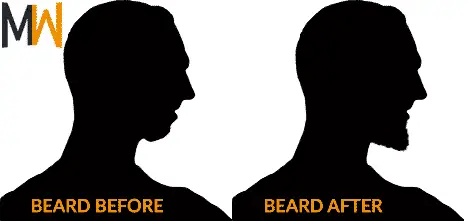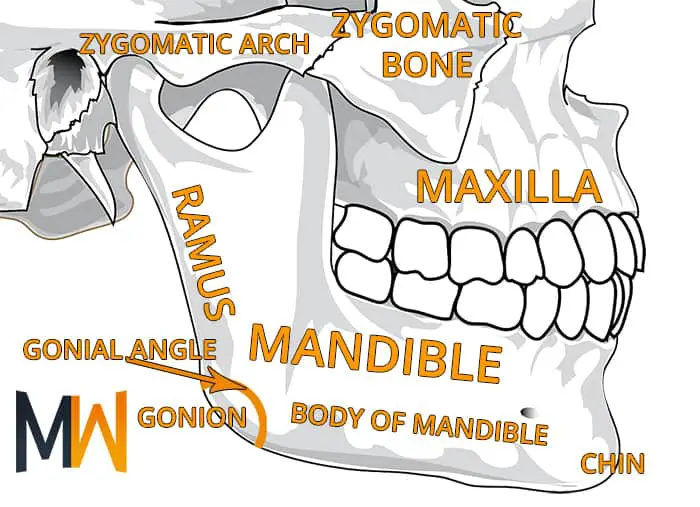
Along with the eyes, the jawline is arguably the most important part of your face. In this article, I’ll discuss the anatomy of the perfect jawline and what you can do to achieve it.
To improve your jawline, you need to focus on chewing gum, mewing, and losing body fat. Invasive plastic surgeries for your jaw include distraction osteogenesis, genioplasty, and MSDO. Jaw implants can successfully augment the jaw as well.
Importance of the Jawline and Lower Third
The lower third consists of the mandible, maxilla, and chin. Along with the eyes, the lower third is one of the most important parts of your face. Click here to see our guide to the eye area.
The mandible is your lower jaw and creates your jawline. The maxilla is your midface (middle third of your face). It is responsible for your facial width, cheekbones, and eye area.
Testosterone helps stimulate jaw growth. Jaw width correlates with how tall you are. When girls check out your jaw, they’re going to make several assumptions about you right off the bat: that you’re tall, aggressive, and dominant.
See our Looks Theory episode for more information about the importance of the mandible and lower third:
Attractive Jawline Characteristics
The chin should extend as far as the forehead. Even a few millimeters of under-projection (mandibular deficiency) or over-projection (mandibular excess) will mess up your looks.

The facial angle is the angle created by your forehead and mouth. The ideal facial angle should be 90-92 degrees, which creates a straight facial profile. If it’s any less, you have a convex facial profile. If it’s larger, you have a concave facial profile. Several things can throw your facial profile out of whack:
- Forward positioning of your mandible. Retrognathism is too far back, and prognathism is too far forward.
- The size your mandible. Micrognathism is too small of a mandible, and macrognathism is too large.
- Forward positioning of your chin. Can be retrogenic (too far back) or progenic (too far forward).
- The thickness of your chin’s soft tissue chin pad.
The gonial angle of the ideal jaw should be prominent, defined, and around 125 degrees or less for men. Women can get away with a larger gonial angle. A gonial angle that is too large means your jaw is probably sinking due to mouth breathing and posterior rotational growth.
The male mandible is wider by the gonial angle and overall larger than the female mandible. The gonial region in men is more angular. The ramus drops straight down and turns forward sharply. But in women, the gonial curve is much more gradual and gentle.

The inferior border of the jawline should be prominent and clearly defined, creating a clear separation between the face and neck. If this is absent, it could be due to:
- an increased gonial angle
- a jaw with too much posterior rotational growth (increased mandibular plane angle)
- a reduced mandible length
- excess tissue/fat
- or any combination of the above
Ideal Jaw Proportions:
To find out if your jaw is normal, you should take front and side profile photos of your head in the natural head position. This is difficult to get exactly right and all photos are going to have some sort of distortion, so some of your dimensions may appear to be off.
Here are some jaw proportions that can tell you how close you are to normal/ideal:
Ramus Height to Mandibular Body Length (5:7)
Maxillary Length to Mandibular Body Length (2:3)
Anterior Cranial Base Length to Mandibular Body Length (1:1)
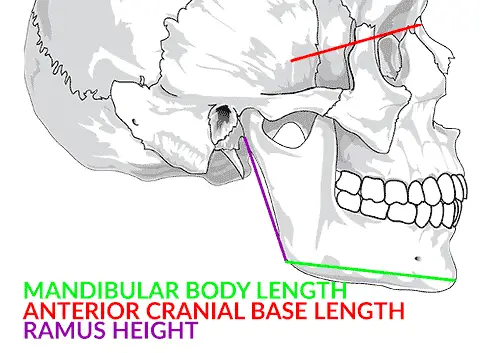
Normal values (mm):
Mandibular Body Length: 119 ± 5
Ramus Height: 59 ± 4
Anterior Cranial Base Length: 72 ± 3
Bigonial Width
The bigonial width is the distance between the two gonions of your jaw:
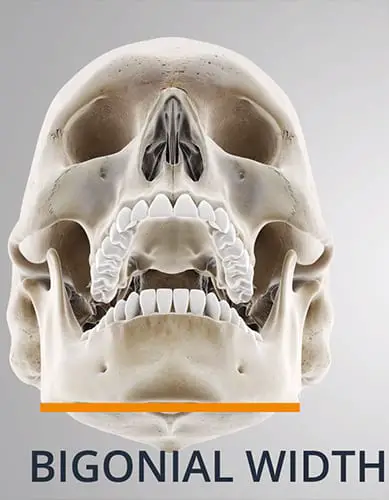
Basically, this is the “width” of your jaw when viewed from the front. The normal bigonial width is 99-113 mm. for men and 90-100 mm. for women. The bigonial width should be around 80-85% of the bizygomatic width (widest part of your face by your cheekbones).
Malocclusions
Malocclusions can occur when the mandibular body length is either too long or too short, leading to an overbite or underbite. There are 3 classes of malocclusion which orthodontic surgeons normally treat.
If you have malocclusions, you have an improperly developed jaw.
Mandibular Plane Angle
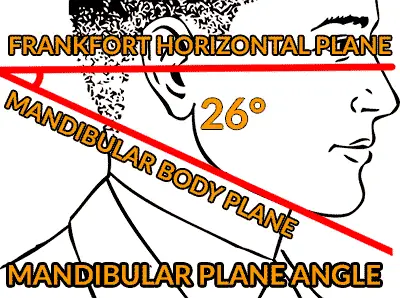
The mandibular plane angle can determine how “long” your face is. Mainly, a face is long when the maxilla and/or mandible have sunk enough to mess up your proportions. If your mandibular plane angle is too high you have a hyperdivergent facial growth pattern aka. “long face”. If it’s too low you have a hypodivergent facial growth pattern aka short face. The ideal mandibular plane angle for men is 26 degrees.
Lips
The lips are an extremely important part of your lower third. It’s the part that the opposite sex wants to kiss. For men, you just don’t want the lips to be too thin and wispy. Ideally, you’d have a macho mouth look. See our article to learn how to get fuller lips for guys where we’ll teach you how to attain this. Women should look into lip fillers, which are pretty standard in society now.
Hyoid
The hyoid bone is a free-floating bone that supports the tongue:
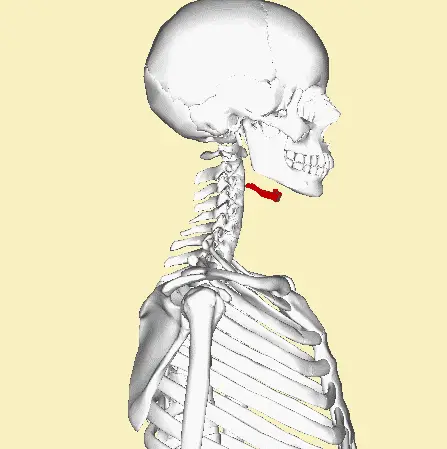
Its positioning has a huge impact on your facial profile. It should be about the same level as the chin. Otherwise, it will give a double chin appearance, even if the person is not overweight.
The angle between your mandible and your neck is the submental-cervical angle. This angle is determined by both body fat and the hyoid bone position. Having a low set hyoid bone also contributes to sleep apnea.

The positioning of the hyoid bone is essentially determined by genetics and also by proper tongue posture during development. Moving your tongue to the roof of your mouth contracts the muscles that move your hyoid up. If you have a lifetime of proper tongue positioning, it’s unlikely you will have a low hyoid. For more information on mitigating the disastrous consequences a low hyoid can have on your looks and facial profile, check out our article on the hyoid bone and how to get rid of the double chin.
Chin
The chin should be harmonious with the rest of your facial features because it determines the facial profile and facial angle. If your chin is receded or over-projecting it could be due to the following:
- the forward position of your mandible
- the size of your mandible
- the size/position of your bony chin
- anterior/posterior rotation of the mandible
- the thickness of your chin’s soft tissue pad, etc.
However, if your protruding chin is due to a prognathic mandible (protruding jaw), then you need mandibular osteotomy (your jawbone is cut and moved back).
Maybe your protruding chin is just from excess bone on the chin itself, in which case you need a horizontal reduction genioplasty to shave bone off your chin. Or your jaw could be too set back and your chin too large, in which case you’d get mandibular advancement and genioplasty to shave off the bone.
You should discuss this with your surgeon. Make sure you find someone experienced and accredited in these types of surgeries. They should have plenty of reviews and before/after pictures of actual patients that they’ll actually show you.
Beard
The biggest impact a beard can have is to increase the perceived size of your jaw. Growing out a beard can fix a recessed/weak jaw. Any mandibular deficiency that exists is literally filled in by beard hair.
Dan Bilzerian’s beard helps him look extremely dominant but it also mitigates the appearance of his overly long midface.

By making the jaw appear larger, the overall proportions of his face appear closer to normal.
Jawline Exercises
The main exercises you can do for your jaw is mewing, which is a long term strategy, and gum chewing, which yields short term and long term results. Starting when you’re young will yield the best results for either of these exercises. It’s difficult to change bones in adulthood, but still possible over years and decades.
Mewing
Mewing is literally just proper tongue posture. Unfortunately, most of us don’t have it, and we have to ingrain the habit into our everyday lives, which isn’t an easy process. Proper tongue posture basically consists of keeping your tongue on the roof of your mouth, especially the back third of your tongue.

The upward force generated by mewing will act on your cheekbones and cause them to become prominent, increasing your facial width. The upwards force of your tongue also pushes down on your ramus, which will increase your gonial angle. The masseter muscles are the antagonist muscles to the tongue. Mewing therefore also activates the masseter muscles and over time can lead to a larger jaw.
For more information on mewing, check out our Ultimate Mewing Guide.
Gum Chewing
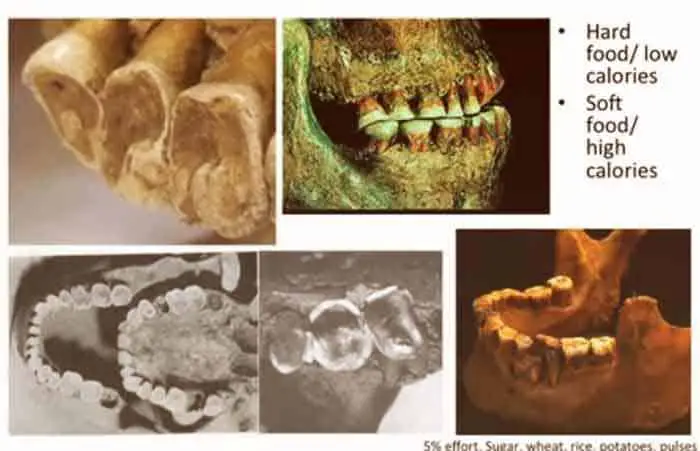
These pictures compare a prehistoric human’s teeth to that of a modern human. You can see that the prehistoric human has worn down teeth. Years of chewing tough foods have really filed them down. In ancient times, we had to work really hard to get the nutrients out of our food. But now our diet contains soft carbohydrates that require almost no work on our part.
Chewing gum will make up for this. It will increase the size of our masseter muscle, leading to the appearance of a larger jaw. But there are two important points about this exercise you need to understand to realize why it’s one of the most important things you can do for your jawline:
- This isn’t necessarily an exercise for life. You’ll always be chewing food, so the gains that you get from gum chewing are essentially permanent, with little to no upkeep.
- The bone will actually proliferate on your gonial angle in response to the stress placed by the masseter muscle from chewing. In contrast, patients with muscular dystrophy have very underdeveloped gonial angles. But changing your actual bone structure will require years, if not a decade, of consistent chewing.
I recommend Falim gum. It’s dirt cheap, hard, and has no sugar, although it doesn’t taste great. Start slow. If you get pain in your jaw joint, you’ve gone too far. Do this as often as you can, and rest your jaw as well, just like you would with muscles you work out at the gym. Work up to several hours per day. Or start with normal gum if you don’t chew gum at all.
Fillers
If you haven’t heard of fillers, it is a type of gel that can be injected deep into the facial tissue. The beautiful thing about them is that they are made of a substance that our body produces naturally as well (hyaluronic acid). If you get a result you don’t like, the filler can also be easily dissolved, unlike with plastic surgery.
A canula (think of an IV) is inserted into your face and pumped with this filler. It stings a little bit, but it’s not bad when you consider the fact that you’re not getting plastic surgery.
Fillers can fill out defects, or augment certain features.
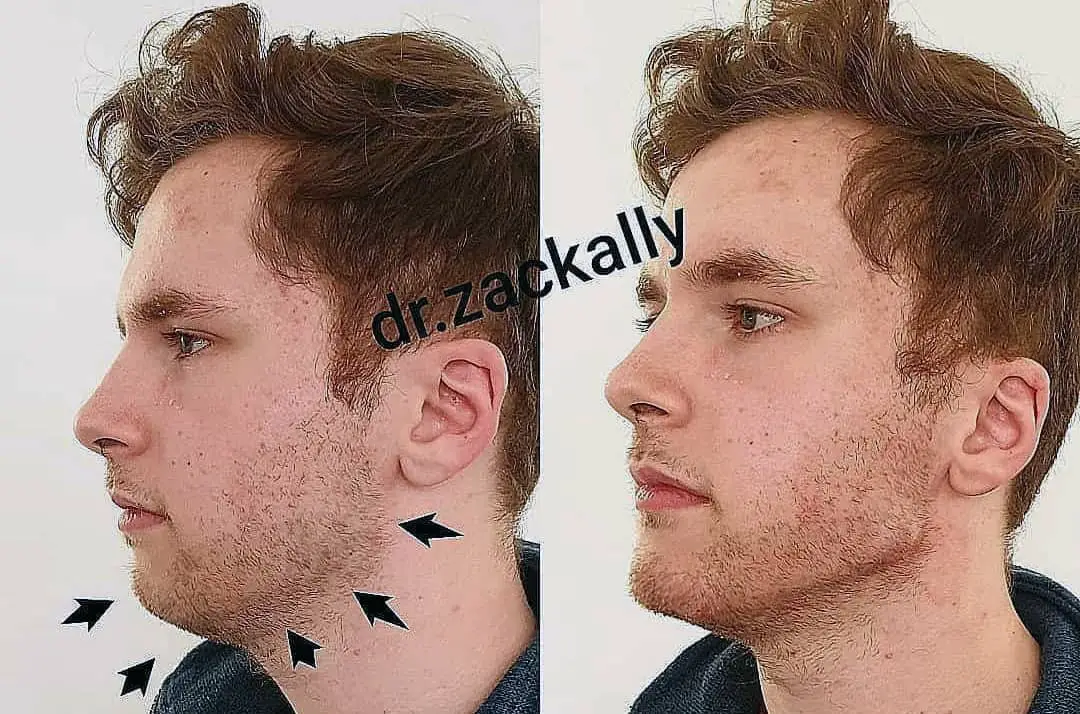
In the above picture, the injector did a good job of adding mass to the existing bone, and the patient has gained a more pronounced jawline. The downside is that this is almost prohibitively expensive when you have to use that much filler. If I had to guess, this cost thousands of dollars at the least. On top of that, you’ll have to get it topped off every 4 months. An implant would be a better choice by this point.
Even worse, filler isn’t good at holding its shape. The above picture was taken right after injection and looks great. Within days, I’d venture to say the patient lost much of his sharpness.
However, if you go the filler route, you want an injector that knows the differences between male and female facial structure. You want someone who’s good at using filler to augment, instead of “fill in” existing features. But this can be challenging with fillers because they’re inherently a soft substance. They’re not ideal for augmentation or making hard edges.
Personally, I recommend avoiding filler altogether if you need that kind of work done. Instead, you should consider surgery or jaw implants.
Jaw Implants
Jaw implants are custom-created pieces of silicone that a surgeon will graft directly on top of your existing bone. Unlike fillers, these will actually hold their shape.
First, a CT scan is done of your skull, and then custom 3d modeling software will be used to show you exactly what you will look like after the surgery so that there’s no guesswork.

Here is a before/after of jaw implants by MixedMakeup:
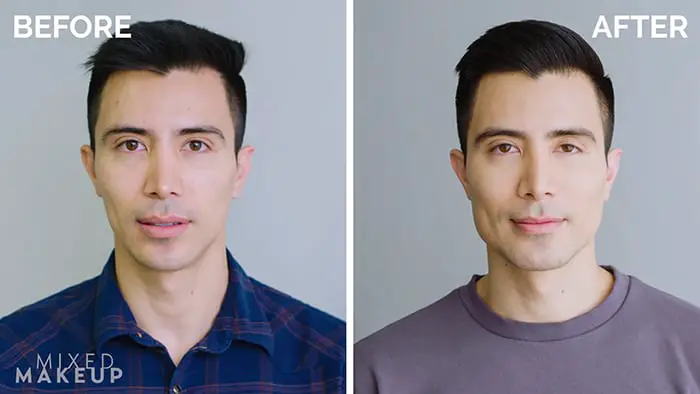
Surgeries
Jaw surgeries are done by oral and maxillofacial surgeons and plastic surgeons. With surgeries for your jaw, it helps to have a medical reason to get it done, such as sleep apnea or malocclusion. Most of the time a truly recessed jaw will indeed cause health problems, and you’ll be able to get it covered by insurance. If this applies to you, getting this surgery should be your number one priority if you want to optimize your looks.
With whatever surgery you pick, keep in mind that you’re looking at 3 months of brutal recovery, possibly having to eat through a straw the whole time. In addition, though it will make you look better, it won’t completely transform you or make you look like a different person.
Distraction Osteogenesis
Distraction osteogenesis is the most common way to get a larger jaw. This is a surgery that forces your body to grow its own bone. The surgeon creates a fracture and installs an appliance that gradually moves the fracture further and further apart. The body attempts to heal and fill in the gap, and the bone increases in length. My recommendation is to find a surgeon very skilled in and with lots of experience in distraction osteogenesis.
The video below goes into more detail about distraction osteogenesis:
Genioplasty
Genioplasty is your surgery of choice if you have a convex facial profile and just need to augment your chin. Basically, the surgeon will cut your chin bone either diagonally or horizontally and then advance your chin forward.
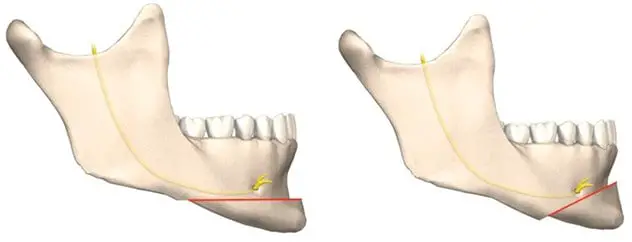
The chin bone easily heals and your chin gains increased projection. Here is a before/after picture:
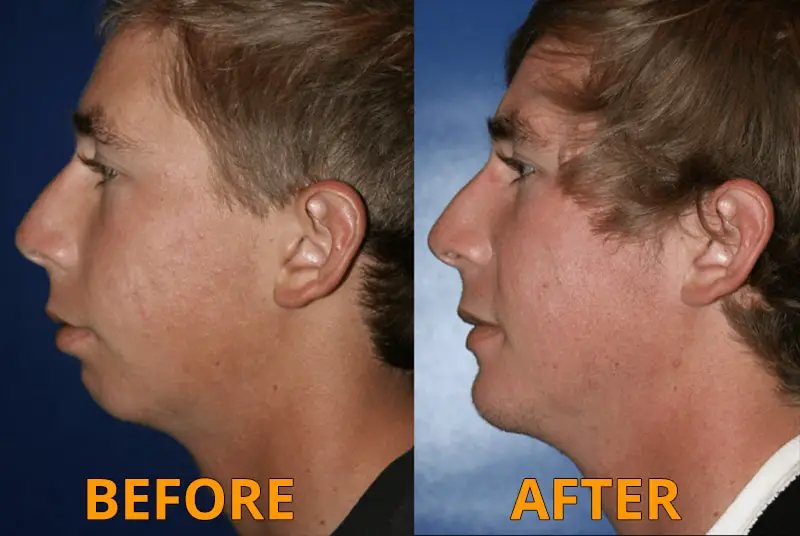
MSDO
MSDO stands for mid-symphyseal distraction osteogenesis. The chin is split at the midline, and a device is installed to help expand the chin:
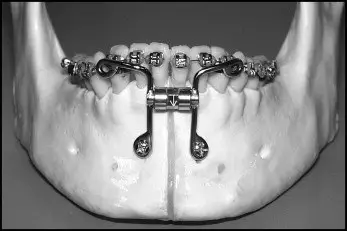
The jaw widens as a result, however, the bigonial width stays the same. This is usually done after the MSE treatment (which expands the maxilla). While this is a minimally invasive surgery as far as jaw surgeries go, make no mistake, it hurts. The bone is expanded at a rate of 0.5mm every 12 hours (1mm per day).
Genioplasty + MSDO + Rapid Palatal Expansion
Chaudhary et al. (2015) reported a case study of a 14-year-old with crowded teeth and basically all the symptoms you expect from a small jaw.
- First, they did MSDO and started splitting his chin. The chin was cut in half and they split it at a rate of 1 mm per day.
- Two weeks after, they expanded his upper jaw with rapid palatal expansion.
- They then fitted him with orthodontic appliances to fix his teeth.
- He was then given a genioplasty to augment his chin.
- And then finally, 8 weeks after the genioplasty, they took off the appliances.
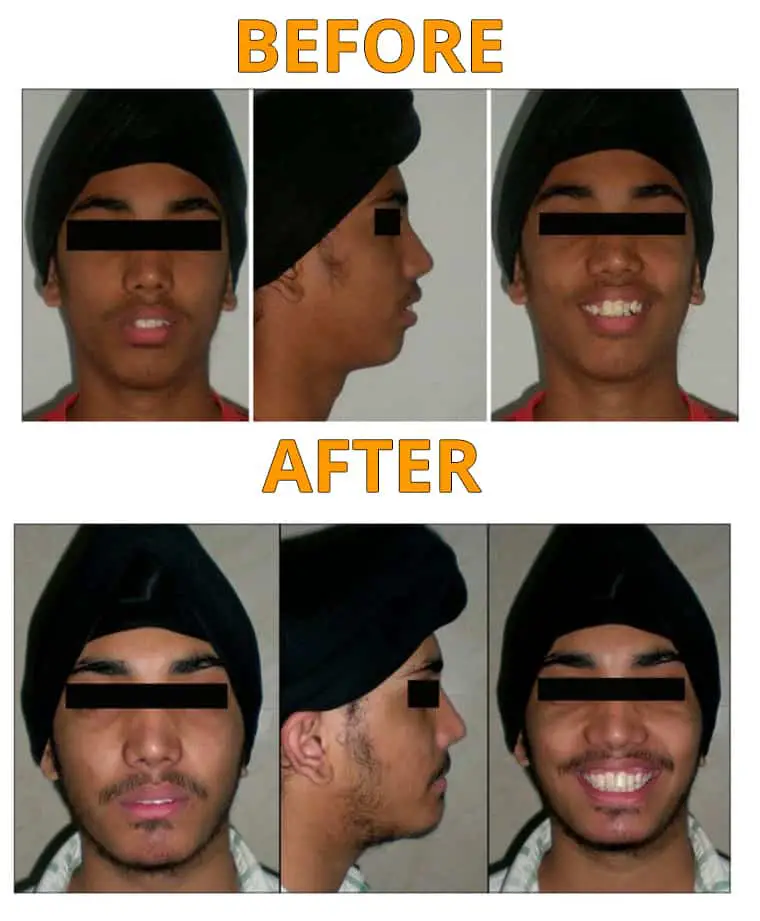
His jaw was small enough that traditional extractions would have compromised his tongue space and facial aesthetics. The key is to find orthodontists who are actually good and will take facial aesthetics into account instead of just trying to fix your functional problems.


